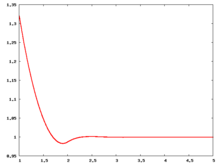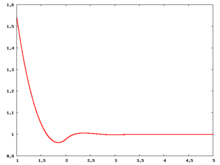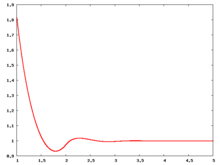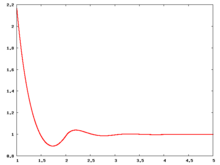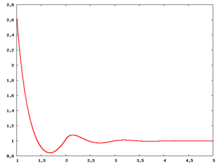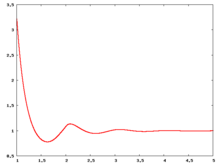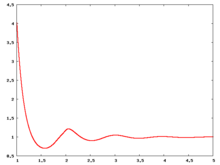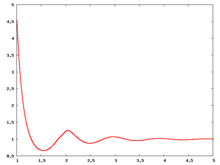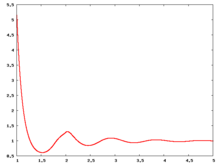Hard sphere model: Difference between revisions
m (Better defined r) |
Carl McBride (talk | contribs) m (Added a reference to the ellipsoid model in the intro.) |
||
| Line 9: | Line 9: | ||
where <math> \Phi_{12}\left(r \right) </math> is the [[intermolecular pair potential]] between two spheres at a distance <math>r := |\mathbf{r}_1 - \mathbf{r}_2|</math>, and <math> \sigma </math> is the diameter of the sphere. | where <math> \Phi_{12}\left(r \right) </math> is the [[intermolecular pair potential]] between two spheres at a distance <math>r := |\mathbf{r}_1 - \mathbf{r}_2|</math>, and <math> \sigma </math> is the diameter of the sphere. | ||
The hard sphere model can be considered to be a special case of the [[hard ellipsoid model]], where each of the semi-axes has the same length, <math>a=b=c</math>. | |||
==First simulations of hard spheres== | ==First simulations of hard spheres== | ||
The hard sphere model was one of the first ever systems studied: | The hard sphere model was one of the first ever systems studied: | ||
Revision as of 10:25, 25 July 2008
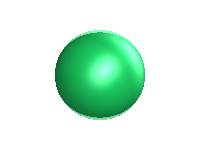
The hard sphere intermolecular pair potential is defined as
where is the intermolecular pair potential between two spheres at a distance , and is the diameter of the sphere. The hard sphere model can be considered to be a special case of the hard ellipsoid model, where each of the semi-axes has the same length, .
First simulations of hard spheres
The hard sphere model was one of the first ever systems studied:
- Marshall N. Rosenbluth and Arianna W. Rosenbluth "Further Results on Monte Carlo Equations of State", Journal of Chemical Physics 22 pp. 881-884 (1954)
- W. W. Wood and J. D. Jacobson "Preliminary Results from a Recalculation of the Monte Carlo Equation of State of Hard Spheres", Journal of Chemical Physics 27 pp. 1207-1208 (1957)
- B. J. Alder and T. E. Wainwright "Phase Transition for a Hard Sphere System", Journal of Chemical Physics 27 pp. 1208-1209 (1957)
Radial distribution function
The following are a series of plots of the hard sphere radial distribution function (the total correlation function data was produced using the computer code written by Jiří Kolafa). The horizontal axis is in units of where is set to be 1. Click on image of interest to see a larger view.
The value of the radial distribution at contact, , can be used to calculate the pressure via the equation of state (Ref 5 Eq. 1)
where the second virial coefficient, , is given by
- .
Carnahan and Starling (Ref. 6) provided the following expression for (Ref. 5 Eq. 3)
where is the packing fraction.
Over the years many groups have studied the radial distribution function of the hard sphere model:
- John G. Kirkwood, Eugene K. Maun, and Berni J. Alder "Radial Distribution Functions and the Equation of State of a Fluid Composed of Rigid Spherical Molecules", Journal of Chemical Physics 18 pp. 1040- (1950)
- B. R. A. Nijboer and L. Van Hove "Radial Distribution Function of a Gas of Hard Spheres and the Superposition Approximation", Physical Review 85 pp. 777 - 783 (1952)
- B. J. Alder, S. P. Frankel, and V. A. Lewinson "Radial Distribution Function Calculated by the Monte-Carlo Method for a Hard Sphere Fluid", Journal of Chemical Physics 23 pp. 417- (1955)
- Francis H. Ree, R. Norris Keeler, and Shaun L. McCarthy "Radial Distribution Function of Hard Spheres", Journal of Chemical Physics 44 pp. 3407- (1966)
- W. R. Smith and D. Henderson "Analytical representation of the Percus-Yevick hard-sphere radial distribution function", Molecular Physics 19 pp. 411-415 (1970)
- J. A. Barker and D. Henderson "Monte Carlo values for the radial distribution function of a system of fluid hard spheres", Molecular Physics 21 pp. 187-191 (1971)
- J. M. Kincaid and J. J. Weis "Radial distribution function of a hard-sphere solid", Molecular Physics 34 pp. 931-938 (1977)
- S. Bravo Yuste and A. Santos "Radial distribution function for hard spheres", Physical Review A 43 pp. 5418-5423 (1991)
- Jaeeon Chang and Stanley I. Sandler "A real function representation for the structure of the hard-sphere fluid", Molecular Physics 81 pp. 735-744 (1994)
- Andrij Trokhymchuk, Ivo Nezbeda and Jan Jirsák "Hard-sphere radial distribution function again", Journal of Chemical Physics 123 024501 (2005)
- M. López de Haro, A. Santos and S. B. Yuste "On the radial distribution function of a hard-sphere fluid", Journal of Chemical Physics 124 236102 (2006)
Direct correlation function
For the direct correlation function see:
Fluid-solid transition
The hard sphere system undergoes a fluid-solid first order transition (Ref. 1). The fluid-solid coexistence densities () are given by
Reference 1.041 0.945 Ref. 1 1.0376 0.9391 Ref. 2 1.0367(10) 0.9387(10) Ref. 3 1.0372 0.9387 Ref. 4 1.0369(33) 0.9375(14) Ref. 5 1.037 0.938 Ref. 6
The coexistence pressure is given by
Reference 11.567 Ref. 2 11.57(10) Ref. 3 11.54(4) Ref. 5 11.50(9) Ref. 7 11.55(11) Ref. 8
- William G. Hoover and Francis H. Ree "Melting Transition and Communal Entropy for Hard Spheres", Journal of Chemical Physics 49 pp. 3609-3617 (1968)
- Daan Frenkel and Berend Smit "Understanding Molecular Simulation: From Algorithms to Applications", Second Edition (2002) (ISBN 0-12-267351-4) p. 261.
- Andrea Fortini and Marjolein Dijkstra "Phase behaviour of hard spheres confined between parallel hard plates: manipulation of colloidal crystal structures by confinement", Journal of Physics: Condensed Matter 18 pp. L371-L378 (2006)
- Carlos Vega and Eva G. Noya "Revisiting the Frenkel-Ladd method to compute the free energy of solids: The Einstein molecule approach", Journal of Chemical Physics 127 154113 (2007)
- Eva G. Noya, Carlos Vega, and Enrique de Miguel "Determination of the melting point of hard spheres from direct coexistence simulation methods", Journal of Chemical Physics 128 154507 (2008)
- Ruslan L. Davidchack and Brian B. Laird "Simulation of the hard-sphere crystal–melt interface", Journal of Chemical Physics 108 pp. 9452-9462 (1998)
- N. B. Wilding and A. D. Bruce "Freezing by Monte Carlo Phase Switch", Physical Review Letters 85 pp. 5138-5141 (2000)
- Robin J. Speedy "Pressure of the metastable hard-sphere fluid", Journal of Physics: Condensed Matter 9 pp. 8591-8599 (1997)
Solid structure
Equations of state
- Main article: Equations of state for hard spheres
Virial coefficients
- Main article: Hard sphere: virial coefficients
Experimental results
Pusey and van Megen used a suspension of PMMA particles of radius 305 10 nm, suspended in poly-12-hydroxystearic acid:
For results obtained from the Colloidal Disorder - Order Transition (CDOT) experiments performed on-board the Space Shuttles Columbia and Discovery see Ref. 3.
External links
- Hard disks and spheres computer code on SMAC-wiki.
Related systems
Hard spheres in other dimensions
- 1-dimensional case: hard rods.
- 2-dimensional case: hard disks.
- Hard hyperspheres
References
- Robin J. Speedy "Pressure of the metastable hard-sphere fluid", Journal of Physics: Condensed Matter 9 pp. 8591-8599 (1997)
- Robin J. Speedy "Pressure and entropy of hard-sphere crystals", Journal of Physics: Condensed Matter 10 pp. 4387-4391 (1998)
- Z. Chenga, P. M. Chaikina, W. B. Russelb, W. V. Meyerc, J. Zhub, R. B. Rogersc and R. H. Ottewilld, "Phase diagram of hard spheres", Materials & Design 22 pp. 529-534 (2001)
- W. R. Smith, D. J. Henderson, P. J. Leonard, J. A. Barker and E. W. Grundke "Fortran codes for the correlation functions of hard sphere fluids", Molecular Physics 106 pp. 3-7 (2008)
- Fu-Ming Tao, Yuhua Song, and E. A. Mason "Derivative of the hard-sphere radial distribution function at contact", Physical Review A 46 pp. 8007-8008 (1992)
- N. F.Carnahan and K. E.Starling,"Equation of State for Nonattracting Rigid Spheres" Journal of Chemical Physics 51 pp. 635-636 (1969)






